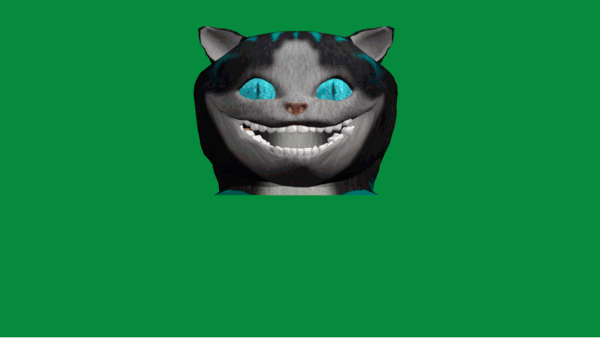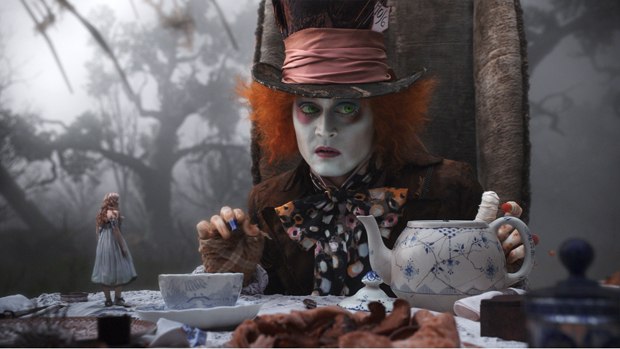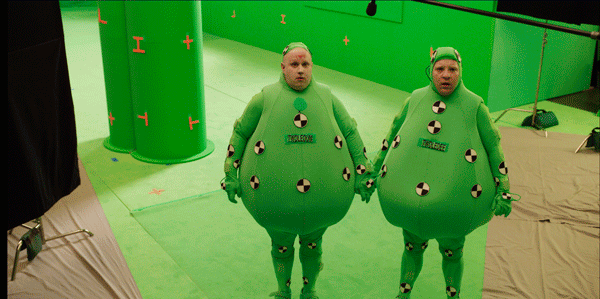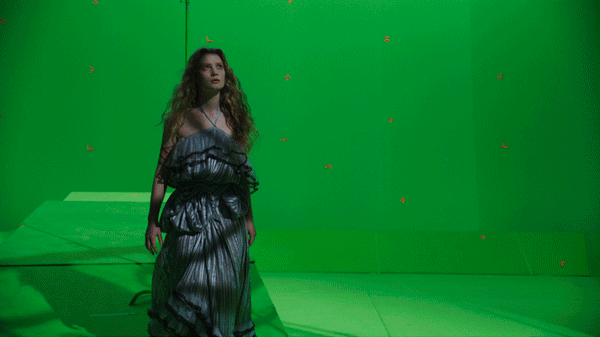Find out how Sony Pictures Imageworks pulled off Tim Burton's Alice in Wonderland.
Check out the Alice in Wonderland trailers and clips at AWNtv!
Alice in Wonderland, the latest psychedelic dream child of Tim Burton, pushes the hybrid film to new heights, thanks to Ken Ralston and his team at Sony Pictures Imageworks. The senior visual effects supervisor tells us what it was like working with greenscreen, animation and a host of other digital tricks for a new kind of synthesis.
Bill Desowitz: Do you still maintain that Alice is like Who Framed Roger Rabbit?
Ken Ralston:
Yeah, it's the only movie I can compare it to in terms of creating an entire world with a lot of technology and a lot of animation and the scale of it all and whatever it takes to make that believable. This seems a lot harder. But, it's as similar as it gets.
BD: And Tim and the producers relied on you to help them understand how it would all look in the end?
KR: Yeah, definitely, that's true. And I'm glad it all worked out. And it was nice to have that trust because what was in front of them was something that and seemed impossible to do. At times it seemed that way to me. But it was pretty crazy on the shoot, especially how fast we were going and how quickly you had to make decisions on your feet, which I like doing. And then in post, too, you have those moments -- especially in the world of CG but on any animation project -- where no one's seeing anything as fast as they want to see it. When you hit those moments, you get the phone calls and you have to calm them down and tell them to have faith. It was pretty craze for Tim Burton, too. He was there working with the animators every day and seeing everything we were doing and we had a very close relationship on this show. It was a very exciting experience for me: I had a lot of creative leeway within his vision to get things going and light things and create environments.
BD: What were some of the biggest breakthroughs as far as raising the bar for hybrid films?
KR:
I think in its own weird way, it's just how interesting it looks to take our greenscreen elements of the actors and finding [creative] ways to put them into these environments that feel, in their strangeness, relatively real, and all the design elements that we can come up with in these shots to enhance the believability. And you forget about it after a while. And it doesn't take long: it starts to feel consistent. There's a continuity to the vision and just making that all work. To me, that's the breakthrough, because it takes so many different tricks and so many different techniques and it's not just about one thing. There are a lot of talented folks taking all that they have at their disposal and going for it.
BD: You've never attempted anything quite like this at Sony before, have you?
KR:
I've never done anything like this. It's really a hodgepodge of tricks, basically, and not just haphazardly thrown in. Everything is designed very specifically, and as we started to figure out what all the different characters were and what we could do to make them interesting and maintain as much of our actors in the shots as we could, we wanted to blend them into this CG world. And with our animated characters, we walked a tightrope to keep it feeling like it's all happening immediately.
BD: And you had such a great assortment of iconic characters to animate, including the White Rabbit, the Cheshire Cat, the Blue Caterpillar, the Bandersnatch and the Jabberwocky. What was it like figuring out how cartoony or not to go with them?
KR:
That was a big deal. The look was important -- just look at the movie. And when we started, with David Schaub as our animation supervisor, we did some pretty toony stuff and putting it in front of Tim. At the time, it was like, 'Yeah, that could be interesting, that could be cool.' Then we started to form the environments around it. Then we started to shoot it and, of course, the movie starts to take on a different reality as it gets further along into its existence. So you start to feel that it's different half-way through the shoot. And eventually even though there's some pretty toony stuff, especially with the March Hare, thank goodness, a lot of it got pulled back more than we thought it would be. That's just how it evolved. I think the Dormouse came together very fast. But trying to find the character of the Cheshire Cat for Tim was very complicated. The White Rabbit was also kind of tough. We had to find out exactly what he was and his mannerisms and the way he would want to behave around our characters. The Jabberwocky was interesting: Tim and I walked in and both had the same idea. Tim said, 'Let's make him a Harryhausen monster,' and I said, 'Yes, thank you, let's go and do this!' That's why it does more of that humanoid standing than originally designed.
BD: And it's all about scale and perspective. What was that like?
KR:
We wanted to make it matter of fact when she falls into this world and changes size. And making it believable the way she relates to these characters. And the Tweedles, which are half-animated, with Matt Lucas' face sort of put in there. What do we do to make that work? I like how we shot it, too, to keep the energy working between all the actors so we weren't shooting separate elements [all the time]. I hate breaking things up.
BD: How did you handle enlarging the heads?
KR: We shot large heads with a 4K camera [the Dalsa Evolution] so we had a high-resolution image to blow stuff up and not lose quality, like VistaVision in the old days. It gave us the opportunity to enlarge Helena Bonham Carter's head, enlarge Mia [Wasikowska's] when she's eight-and-a-half feet tall. Depending on what scale the Tweedles were, we had to enlarge Matt's face on some of the wide shots.
BD: Any noteworthy R&D?
KR: Carey Villegas [one of the visual effects supervisors] and I were working on expanding the Mad Hatter's eyes, so we picked some shots from Ed Wood and did those and sent them over to Tim, and I happened to be there the day that Johnny [Depp] was visiting in England. They came in and cracked up and loved it, so that sold it right then and there. We enlarged his eyes and had to match the man and constantly keep them tracking to Johnny's real eyes. And it got harder whenever he got into a perspective change: we'd have to warp stuff and make it blend in better. But that was the technique.
BD: And did you use the Arnold renderer?
KR:
Yes, we did. As terrifying as that was at the start, we created a lot of breakthroughs with that and I'm very happy with [the results]. As difficult as some of the issues were with rendering times and image quality because of the immense size of some of the shots we did, I love lighting with it. I really enjoyed it much more than anything else I used. It's much more intuitive in a weird way. And right out of the box, you could get something that looked a little bit more organic, which was key to this film.
It's more naturalistic than what I'm used to. It's like when I'm shooting miniatures and the stuff I've done in the past, you can tell. There's such a nice softness to some of the light, if that's what you want, and it has a nice quality to how the ambient light bounces back into the image. At least you're off on the right foot instead of beating your head on some of these things, trying to do something that vaguely looks organic and natural.
BD: The execution scene is pretty complicated. How did that come together?
KR:
Well, it's sort of what the whole movie looked like at one point. We shot our principals: Helena, Johnny, Crispin [Glover]. And green everywhere, and no extras. All we had were a couple of stand-in people in green to let you know where they would be. We had voice talent in green up on the podium basically they're up on the balcony with the Red Queen. They're the group that's always following her around, but we hadn't quite figured out who they were or what they looked like yet. Our voice talent did the dialogue, and, of course, we're doing the CG environment that's surrounding everybody, as we're trying to find ways to blend stuff in a nice way. The CG animals were all going to be animated in here. Late in the game, Tim came up with the idea that we needed to sprinkle in more of our animals in here because they're really the ones who've been enslaved and they really want to come forward when the Red Queen's getting hers. It added a lot to the moment.
So, we shoot all of that material and enlarging the Red Queen's head; and we're putting an animated body on Stayn [Glover] -- it looks like his body but thinner and more distorted than normal; all the simulated cloth work; and also creating steam or smoke coming out the hole where obviously the head's fallen into. Then we go back a month later and replicate every angle with all of our extras and re-doing all that stuff, lighting the whole thing in six days. And then I came up with a system that seemed to work out very well to simplify the hell out of all these extras because they're everywhere. So it was a matter of just coming up with basic angles and a couple of different angles and blasting through when we got everyone set up to cover many shots per setup; and in the end just putting it all together with all the pieces necessary. It was quite an undertaking. And Rob Stromberg [the production designer] came back and did a lot of matte paintings for the show and he had some of his guys doing the matte paintings that surround that CG environment. It's pretty cool.
BD: How was the 3-D process?
KR: Well, the main decision was based on creative flexibility. The time frame was insane, and the tests we did with real 3-D was kind of funky, so by doing it with this conversion idea with CG backgrounds and 3-D, it was a lot more flexible than I had anticipated. And I got a lot more out of being able to get into this stuff and bust up this stuff with Tim. We really had a lot more artistic fun in how we played it. It might've locked us into stuff if we had just done the two-camera thing from the start. We had to shoot a lot of it 2-D anyway because of the Dalsa camera and the Red Queen scale stuff. That was only one camera, so it kept leading us down certain paths and we took the best idea at the time. It worked fine.
Bill Desowitz is senior editor of AWN & VFXWorld.













